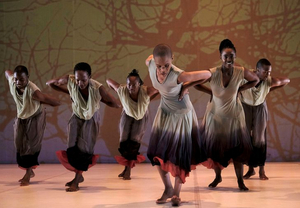Review: The Festival d'Avignon Presents LE SACRIFICE By Dada Masilo
Lighting designer Suzette le Sueur integrates an upstage projection of silhouettes of dead branches.

Choreographer Dada Masilo, a South African native, studied dance at Anne Teresa de Keersmaeker's school in Brussels. While there she developed an appreciation for the grand patrimonial dance-works. Her company, Dance Factory Johannesburg, has made a name for itself through oftentimes-comedic deconstructions of European classics like Swan Lake, and Giselle. In Le Sacrifice Masilo has decided to address a different dance classic, Le Sacre du Printemps. It was a long road to the Festival for Le Sacrifice, now performing in Avignon's Cour du Lycée Saint-Joseph. The piece has been twice canceled due to Covid. While her movement vocabulary lacks in imagination, the performances themselves were thrilling.
The piece opens with Masilo walking across a bare stage. Her arms and hands furl, opening and closing. Singer Ann Masina, who has a bountiful repertoire from opera, to soul, to folk, joins her. Masina spends the majority of the performance off-stage, but in audience view, with the live band. The dance company then joins Masilo. This sequence is the rise before the fall. It is a sequence of great joy. The rest of the band, Tlale Makhene, Leroy Mapholo, and Nathi Shongwe, are not passive observers. Their presence on stage is recognized. Says one of the ensemble members to the musicians, "No no no no no. It is too hot. Look at us sweating up here! Slow it down a little bit for us." The band obliges. Where the work excels is in moments of percussiveness. Masilo's inspiration from the cacophonic rhythms of Le Sacre du Printemps land with force. The ensemble claps, beats its feet, and chants in kaleidoscopic patterns. It is human without being actorly and precise without being plastic. It is also believably joyful.
Masilo's less resonant moments come in acts of meditative intensity. The choreographer comes back on stage, evoking the movements she opened the piece with. Another dancer slowly walks to her holding a lily. It's a moment that could capture our attention. However, the large corps continues to disjointedly dance behind them, distracting our attention. Other moments, such as solos not held by Masilo, and small groups exhibit fairly run of the mill choreography. This isn't a fault in and of itself, but if the work is in conversation with Le Sacre du Printemps, a thread is lost. Thankfully Masilo rescues the work's final moments by being alone on stage with Masina. Her voice soars over Masilo's sacrificed body.
Lighting designer Suzette le Sueur integrates an upstage projection of silhouettes of dead branches. It might have benefited to being put on a sheet. The in-situ wall of the Cour muddied the effect. Costumes by David Hutt are light and flowing. They react with ease to the movements of the dancers. Lastly, music by the aforementioned band is beautifully integrated into the evening's work. They are a Greek chorus, serving as comic relief, and mourning with us in due measure.
Reader Reviews
Videos

